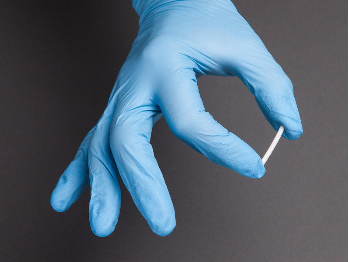Probuphine

New Medications For Treating Opioid
A new method of delivering medication for opioid addicts gained approval from a Food and Drug Administration advisory panel this week. It’s a matchstick-like insert designed to slip under the skin and release a drug over a period of months. Some physicians say the implant will be a useful addition to the currently short lineup of medication-assisted treatment options.
The rod is called Probuphine, developed by the companies Braeburn Pharmaceuticals and Titan Pharmaceuticals. It contains a medication called buprenorphine which the FDA approved for opioid addiction in 2002 and is currently widely in use. The FDA typically follows the advice of its advisory panels on approvals.
This molecule binds to opioid receptors in the body, but doesn’t hit them as hard as something like heroin or morphine would. So it can reduce cravings without giving a full high.It’s often taken in combination with a medication called naloxone, which negates the effect of any additional opiates and acts as an antidote for overdoses. Right now, patients must hold a tablet or a film under their tongue or in their cheek until it dissolves every day.
Dosage Frequency For Opioid Treatments
There are four medications used to assist treatment for opioid use disorders, all of which are available in daily-dose oral form. The FDA review board has recommended for approval a time- release implant for buprenorphine, which could last up to six months.
| Oral Dose | Injection | Implant | |
|---|---|---|---|
| Buprenorphine | Daily | Weekly or monthly (not yet available) | Every six months |
| Buprenorphine/naloxone | Daily | — | — |
| Column 0 Value | Daily | Monthy | — |
| Column 0 Value | Daily | — | — |
Source: Substance Abuse and Mental Health Services Administration
Credit: Katie Park/NPR, pill and syringe icons by Sergey Demushkin from the Noun Project
This gives a long-lasting implant a few advantages over oral daily doses. Probuphine lasts up to six months. So unless patients want to dig underneath their skin to tear the thing out, there’s no deviating from the treatment.
“With the Suboxone [a daily combination of buprenorphine and naloxone], you can go on these drug holidays,” says Patrick Kennedy, a former congressman and former opiate addict who urged the panel to approve Probuphine. “If I knew I had access to another drug, OxyContin, I would just stop taking the Suboxone and — you know.” And with the oral medications, health providers worry that patients with a prescription might sell the medication illegally. Buprenorphine is commonly confiscated by the Drug Enforcement Agency, says Behshad Sheldon, president and CEO of Braeburn Pharmaceuticals. “And sometimes it’s actually unfortunately accidentally ingested by children.” The Probuphine implant would reduce those incidents, she says.
On top of that, Sheldon says the implant’s long-acting nature will give patients peace of mind. “They won’t have to think about where their medicine is or worry if it gets lost or stolen. One of the first things I’ve read [from patients] is ‘I want the implant because if you go to jail, they can’t take it from you.'”
But it wouldn’t be for everybody. “It’s really for those doing well on buprenorphine and don’t need a high dose,” says Dr. Adam Gordon, a professor of medicine at the University of Pittsburgh and member of the advisory panel who voted in favor of approving Probuphine.
With the insert, it would be difficult to change a patient’s dosing. Sometimes, within a few months patients need to go on a higher dose of buprenorphine, so Probuphine would be best for people who can get along with a low, constant level of medicine. For different people suffering with addiction, other treatments might be more appropriate.
Right now, there are only two other chemicals for treating opioid addiction: methadone and naltrexone. In broad strokes, each is more suited to different patients and situations, but it’s not always clear-cut, Gordon says. The entry of Probuphine as a potential treatment option has revived longstanding disagreement over how these medications should be administered. Some doctors think certain patients need to be on medicine forever. “Will they need to be on it six more months, maybe many times over their entire life? When is a good time to stop treatment?” Gordon says. “These are unanswered questions.”
Some doctors think buprenorphine, including Probuphine, can be a stepping-stone on a path to being medication-free. “Buprenorphine is a way to withdraw someone from opiates,” says Dr. David Pickar, a psychiatrist at the Johns Hopkins University School of Medicine on the advisory committee who also voted to approve. “The idea of not having any opiates in your body is very disturbing to some. The buprenorphine will help bridge that. Then you give them naltrexone,” he says. Naltrexone works by blocking the effects of any opioid someone might try consuming. It prevents the high, potentially stopping a relapse. It’s most often taken as a monthly injection, and is likely best for people who haven’t recently been using heavily. Eventually, once someone has regained much of their normal life, Pickar says they might try going off the naltrexone.
But sometimes naltrexone doesn’t work. Some patients never go back for their next dosage. The other option is methadone, which binds to opioid receptors in a way similar to buprenorphine. It’s good for those who used heavily, but it must be administered daily at methadone clinics. “Let me tell you, that is a tough world,” Pickar says. Not everyone can or wants to go to a clinic every day.
Pharmacy companies, including Sheldon’s, are looking to develop new medications and treatments. In the pipeline is a monthly or weekly injection of buprenorphine, which could be better for those who might still need to see a physician often but struggle to take a daily pill. Ultimately, Sheldon says, there need to be more treatments that can be better tailored to individual patients.


